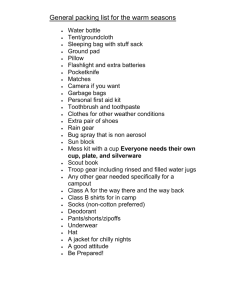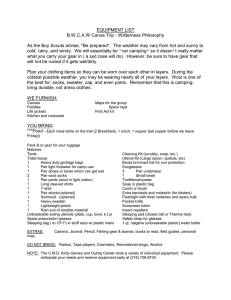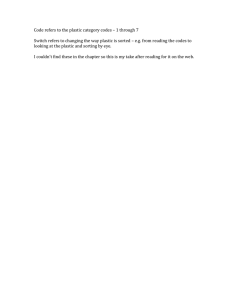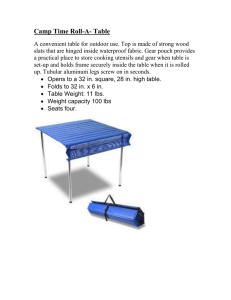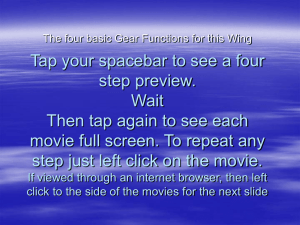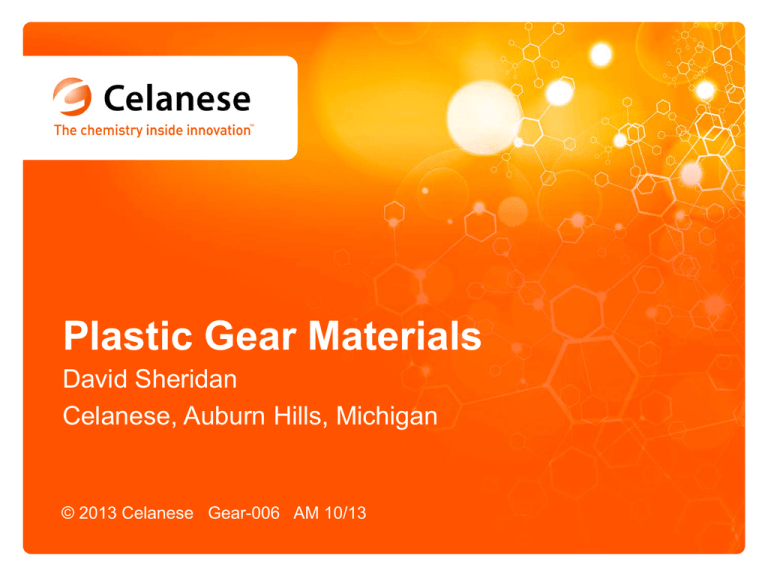
Plastic Gear Materials
David Sheridan
Celanese, Auburn Hills, Michigan
© 2013 Celanese Gear-006 AM 10/13
The Plastic Gear Development Team
Project Engineer
Molder
Tool
Builder
Manufacturing
Engineer
Gear Engineer
Purchasing
Material
Supplier
Plastics Engineer
© 2013 Celanese Gear-006 AM 10/13
Plastic Gear Materials
Quality Control
Engineer
2
Plastic Gear Development
► Identify Application – Voice of the Customer (VOC)
► Define Operating Requirements
‒ Ratio
‒ Prime mover
‒ Torque and speed
‒ Inertia, natural freq.
‒ Load(s)
‒ Torque and speed
‒ Special conditions
‒ Inertia, natural freq.
‒ Precision
‒ Efficiency
‒ Lubrication
‒ Environment
‒ Temperature
‒ Chemical exposure
‒ Moisture exposure
‒ Duty cycle
‒ Test requirements
‒ Life
‒ Other
‒ Physical limits
► Anticipate Future Applications
© 2013 Celanese Gear-006 AM 10/13
Plastic Gear Materials
3
Plastic Gear Development
Select Materials
Preliminary Gear Sizing
► Suit operating environment
‒ Temperature range
► Select materials
► Select preliminary gear geometry
‒ Number of teeth
‒ Dimensional behavior
‒ Property behavior
‒ Size (pitch or module)
‒ Chemical environment
‒ Face width
‒ Dimensional behavior
‒ Property behavior
► Nominal ambient conditions
► Appropriate property mix
‒ Fatigue
► Simple load analysis
‒ K-Factor
‒ Stiffness
‒ Unit load
‒ Impact
‒ Creep
► Interaction with other components
‒ Friction
‒ Wear
For more information see AGMA 920-A01, Materials for Plastic Gears
© 2013 Celanese Gear-006 AM 10/13
Plastic Gear Materials
4
Preliminary Plastic
Gear Sizing
© 2013 Celanese Gear-006 AM 10/13
Preliminary Sizing Process
Power
Ratio
Speed
Inputs
Specifications
Analyze
Final
Design
Advanced
Analysis
© 2013 Celanese Gear-006 AM 10/13
K-Factor / Unit Load
Y
Plastic Gear Materials
Results
OK?
N
6
Preliminary Sizing Process
Plastic Design Feasibility
►K-Factor (surface stress)
►Unit load (bending stress)
Assumptions / Limitations
►External, parallel-axis, single stage gear set
►Load well distributed, perfect shaft alignment
►No center distance variation considered
►Load shared by > 1 pair of teeth
►No tooth errors
►Lubricated environment
© 2013 Celanese Gear-006 AM 10/13
Plastic Gear Materials
7
K-Factor
► Measure of surface stress intensity
‒ Surface durability
► Derived from Hertzian contact stress equation
Sc
‒
‒
► K
EG,P
0.70
1
1
cos
EG E P
sin
K
= Modulus of gear, pinion
= Pressure angle
Sc
© 2013 Celanese Gear-006 AM 10/13
Wear
Plastic Gear Materials
8
K-Factor Calculation
K
ext
Ft
D p, Pinion
1
1
f
NG /NP
Ft = Tangential load
NG = Number of teeth, gear
Dp = Operating pitch diameter
NP = Number of teeth, pinion
f
= Net face width
► Independent of material properties
► Inversely proportional to face width
© 2013 Celanese Gear-006 AM 10/13
Plastic Gear Materials
9
K-Factor
Celcon® M90 vs. Celcon® M90
© 2013 Celanese Gear-006 AM 10/13
Plastic Gear Materials
10
K-Factor
Celcon® GC25A vs. Celcon® GC25A
© 2013 Celanese Gear-006 AM 10/13
Plastic Gear Materials
11
Unit Load (UL)
► Measure of bending stress intensity
‒ Tooth strength
► Derived from Lewis Formula
► UL
Tooth breakage
© 2013 Celanese Gear-006 AM 10/13
Plastic Gear Materials
12
Unit Load Calculation
F Pd
sb
fY
Ft Pd
UL
f
Lewis Formula
Ft = Tangential load
F = Load on cantilever
Pd = Diametral pitch
Y = Lewis geometric factor
f
= Face width
►Independent of material
►Directly proportional to diametral pitch
© 2013 Celanese Gear-006 AM 10/13
Plastic Gear Materials
13
Unit Load
Celcon® M90 vs. Celcon® M90
© 2013 Celanese Gear-006 AM 10/13
Plastic Gear Materials
14
Unit Load
Celcon® GC25A vs. Celcon® GC25A
© 2013 Celanese Gear-006 AM 10/13
Plastic Gear Materials
15
Advanced Ticona Analysis Support
► Additional materials, dry running
► Full design optimization
‒ Profile modification
‒ Tooth tip relief
‒ Tooth strength balance
► Multi-stage gear
trains and housings
► More complex gear
types and arrangements
► Detailed geometry for specifications
© 2013 Celanese Gear-006 AM 10/13
Plastic Gear Materials
16
Plastic Gear Data
Early Plastic Gear Data
► Material properties mixed with gear geometry
‒ Limited acceptance by gear designers
‒ Did not fit with standard gear design
► Limited temperature and environmental data
‒ Property changes not included in design
► Limited understanding of failures
‒ Dry gears wear
‒ Greased gears show wear and bending
‒ Other mechanisms not defined
© 2013 Celanese Gear-006 AM 10/13
Plastic Gear Materials
17
Plastic Gear Data
Present Plastic Gear Data
► Developing properties in terms of temperature
rather than geometry
► Operating temperature prediction possible
► Developing improved testing methods
► Much improved geometry design
Future Plastic Gear Data
► Better load analysis data
► Improved temperature and
environmental effects prediction
► Improved failure
mode understanding
© 2013 Celanese Gear-006 AM 10/13
Plastic Gear Materials
18
Plastic Properties
Strength and Modulus Vary
► Temperature
► Moisture
► Chemical exposure, lubricants
Dimensions Change
► Temperature
‒ Thermal expansion > metals (x10)
► Moisture
► Chemical exposure, lubricants
► Shrinkage, stress relief
© 2013 Celanese Gear-006 AM 10/13
Plastic Gear Materials
19
Effects of Loading Rate and Temperature
Modulus
Stress
Increased
Loading Rate
Crystalline
Tg
Amorphous
Tg
Increased
Temperature
Tm
Temperature
Strain
© 2013 Celanese Gear-006 AM 10/13
Plastic Gear Materials
20
Creep and Fatigue vs. Temperature
Log
Stress
Log
Modulus
Increasing
Temperature
Log Cycles
Log Time
© 2013 Celanese Gear-006 AM 10/13
Increasing
Temperature
Plastic Gear Materials
21
Temperature Limits for Plastic Gears
250
Temperature, °C
220
220
200
170
150
150
150
PBT
PA 6/6
170
130
115
100
Acetal
GF Acetal
© 2013 Celanese Gear-006 AM 10/13
GF PBT GF PA 6/6 GF PPS
Plastic Gear Materials
GF LCP
22
Elastic Modulus
Preferred
Alternate
► DMA curves
► Tensile data
► Parameters
‒ Temperature
► Parameters
‒ Temperature
‒ Moisture
‒ Moisture
‒ Chemical exposure
‒ Chemical exposure
© 2013 Celanese Gear-006 AM 10/13
Plastic Gear Materials
23
Dynamic Mechanical Analysis (DMA)
Tensile Design
Apply
Harmonic
Displacement
Displacement
0
1
2
3
4
5
6
0
1
2
3
4
5
6
7
time
Phase
Shift (δ)
Test
Specimen
Load
7
time
Measure Load
© 2013 Celanese Gear-006 AM 10/13
Plastic Gear Materials
24
Shear Modulus vs. Temperature
for Acetal Copolymer
3000
Shear Modulus (MPa)
2500
2000
Glass Reinforced Grade
1500
Standard Grade
1000
500
0
-80
Impact Modified Grade
-60
-40
-20
0
20
40
60
80
100
120
140
160
180
Temperature (°C)
© 2013 Celanese Gear-006 AM 10/13
Plastic Gear Materials
25
Shear Modulus vs. Temperature
for Acetal Copolymer
10000
S hear M odulus (M P a)
Glass Reinforced Grade
1000
Standard Grade
100
10
-80
Impact Modified Grade
-60
-40
-20
0
20
40
60
80
100
120
140
160
180
Temperature (°C)
© 2013 Celanese Gear-006 AM 10/13
Plastic Gear Materials
26
Typical Acetal Copolymer DMA Curves
Normalized at 23°C
Norm aliz ed M od ulu s
10
1
Glass Reinforced Grade
Impact Modified Grade
0.1
0.01
-60
-40
-20
0
20
40
60
80
100
120
140
160
Temperature (°C)
© 2013 Celanese Gear-006 AM 10/13
Plastic Gear Materials
27
Typical Acetal Copolymer Tensile Data
ISO Method
100
-40°C
90
80
70
23°C
Stress, MPa
60
40
50
40
80°C
30
100°C
20
120°C
10
0
0
2
4
6
8
10
12
14
Strain, %
© 2013 Celanese Gear-006 AM 10/13
Plastic Gear Materials
28
Poisson’s Ratio
► Varies with environmental conditions
► Has minimal effect on calculations
► If specific data is available, use it
► Otherwise use 0.35 for all plastics
© 2013 Celanese Gear-006 AM 10/13
Plastic Gear Materials
29
Bending Fatigue Strength
Preferred
Alternate
► Gear tooth bending
► ASTM D671 fatigue
stress vs. life cycles
(S-N curves)
► Parameters
► Add temperature correction
‒ Temperature
‒ Moisture
‒ Chemical exposure
© 2013 Celanese Gear-006 AM 10/13
Plastic Gear Materials
30
Tooth Root Bending Fatigue Strength
Unfilled Acetal Copolymer Greased vs. Air Temperature
Bending Strength (MPa)
100
20°C
60°C
80°C
100°C
10
1.00E+05
1.00E+06
1.00E+07
1.00E+08
Cycles
© 2013 Celanese Gear-006 AM 10/13
Plastic Gear Materials
31
Tooth Root Bending Fatigue Strength
Hostaform® HS15™ Acetal Copolymer
vs. Low MI Acetal Homopolymer
Gear Performance
Oil Lubricated at 40°C
100
Torque (in-lbf)
90
Hostaform® HS15™ POM
80
Low MI Acetal Homopolymer
70
60
50
100
1,000
10,000
Thousand Cycles to Failure
© 2013 Celanese Gear-006 AM 10/13
Plastic Gear Materials
32
Early Plastic Gear Fatigue Data
© 2013 Celanese Gear-006 AM 10/13
Plastic Gear Materials
33
Acetal Copolymer Fatigue Data
by ASTM D671
100
S tress (M P a)
Glass Reinforced (Cross Flow)
Standard Grade
10
1.0E+04
1.0E+05
1.0E+06
1.0E+07
1.0E+08
Cycles to Failure
© 2013 Celanese Gear-006 AM 10/13
Plastic Gear Materials
34
Acetal Copolymer Fatigue Data
by ASTM D671
10000
S tress (psi)
Glass Reinforced (Cross Flow)
Standard Grade
1000
1.00E+04
1.00E+05
1.00E+06
1.00E+07
1.00E+08
Cycles to Failure
© 2013 Celanese Gear-006 AM 10/13
Plastic Gear Materials
35
Fatigue Temperature Correction
► Use tensile strength curves
‒ Parameters
‒ Temperature
‒ Moisture
‒ Chemical exposure
► Unreinforced
‒ Strength at yield not important, strain too high
‒ Strength at a particular strain (pick 1% strain)
► Reinforced
‒ Strength at a particular strain (try 1%)
© 2013 Celanese Gear-006 AM 10/13
Plastic Gear Materials
36
Typical Acetal Copolymer Tensile Data
ISO Method
40
-40
35
Stress, MPa
30
23
25
40
20
15
80
10
100
120
5
0
0
0.2
0.4
0.6
0.8
1
Strain, %
© 2013 Celanese Gear-006 AM 10/13
Plastic Gear Materials
37
Wear Rate (Dry and Greased Gears)
Preferred
Alternate
► Hertzian contact stress vs. life cycles
► ASTM D3702 ring on disk (thrust
(S-N curves)
► Failure criteria inconsistent
washer) test
‒ Tooth failure
‒ Weight loss
‒ Increase in backlash
‒ Transmission error
► Parameters
‒ Temperature
‒ Moisture
‒ Chemical exposure
© 2013 Celanese Gear-006 AM 10/13
Plastic Gear Materials
38
Permissible Contact Stress
Acetal Copolymer Below 60°C
Contact Stress (MPa)
100
Wear Modified Grades
Standard Grades
10
1.00E+05
1.00E+06
1.00E+07
1.00E+08
1.00E+09
Cycles
© 2013 Celanese Gear-006 AM 10/13
Plastic Gear Materials
39
Tribology When Running Dry
Without Lubricants
Performance of system governed by
► Speed, load, motion type (sliding, rolling…), etc.
► Similar vs. dissimilar materials
‒ Polarity, surface energy, & adhesion of counterparts
► Surface roughness & asperity deformation
‒ Optimum differs with polarities
► Incorporated lubricants, e.g. PTFE, Si, etc.
© 2013 Celanese Gear-006 AM 10/13
Plastic Gear Materials
40
Optimum Surface Roughness
► POM vs. steel
‒ Adhesive and deformative friction
sum
Coefficient of friction
µ
µdef
Optimum
( 1-2 µm )
µadh
Surface roughness ( Steel ) in µm
© 2013 Celanese Gear-006 AM 10/13
Plastic Gear Materials
41
Tribological Mechanisms of
Lubricants and Fillers
A Few Examples:
Mineral / Chalk
► Chalk hardens the POM-matrix and reduces its
wear; in abrasive systems it may increase wear if
it stays in the sliding area.
PTFE
► PTFE is incorporated in POM as a micro powder.
It builds up a lubricating film in between the
sliding partners. As PTFE has a low coefficient of
friction in contact with many materials it reduces
the friction in the system.
Silicone Oil
► Silicone oil is incorporated as liquid droplets.
These droplets continue to come to the sliding
surface as the covering surface layer abrades.
© 2013 Celanese Gear-006 AM 10/13
Plastic Gear Materials
42
Celanese Tribological Grades
Celcon® and Hostaform®
Polytetrafluorethylene PTFE
► Hostaform C 9021 TF / TF5 (Celcon
LW90F2)
► Hostaform C 27021 TF
UHMW-PE
► Hostaform C 9021 G
► Hostaform C 2521 G
Wax
► Hostaform LW90EWX
► Hostaform LW15EWX
► Hostaform C 13021 RM
► Hostaform C 9021 FCT1
► Celcon M140L1
Molybdenum Disulfide
► Hostaform C 9021 M
Chalk
► Hostaform C 9021 K (Celcon LW90)
► Hostaform C 13031 K
© 2013 Celanese Gear-006 AM 10/13
Silicone Oil
► Hostaform C 9021 SOEK (Celcon
LW90SC)
► Celcon LW90S2
► Hostaform LW90BSX
► Celcon LW25S2
PTFE & Silicone Oil
► Celcon LW90FS-K
Special PE
► Hostaform C 9021 AW (Celcon M90AW)
► Hostaform C 9021 SW (Celcon M90SW)
Glass Fiber and Glass Beads
► Hostaform C 9021 GV 1/30 GT
► Hostaform C 9021 GV 3/30 TF2
► Hostaform C 9021 GV 1/20 XGM
Plastic Gear Materials
43
Ticona
Kelsterbach
NEW
rheometer/tribo
meter
© 2013 Celanese Gear-006 AM 10/13
Plastic Gear Materials
44
Celanese Tribological Test Methods
► Capabilities span a wide range of speeds and loads
‒ Ability to measure wear, friction, and noise generation
Different Tribology Tests
1000
Celanese
Kelsterbach
NEW
rheometer/tribomete
r
sliding speed in m/min
100
Celanese USA
ASTM D3702
Ticona
10
1
Celanese Kelsterbach
stick slip (noise) test
Celanese USA
ASTM D1894 slow speed
N
F
0.1
0.001
© 2013 Celanese Gear-006 AM 10/13
0.01
0.1
1
load pressure in MPa
Plastic Gear Materials
10
100
45
Optimizing Sliding Partners
Sliding partners
Plastics
Metal
Steel
Wear
Friction
coefficient
Squeaking
Semi-crystalline Amorphous
(PC, PMMA)
(PBT, PA)
Aluminum
Brass
POM
C 9021
against
itself
AW, BSX, SW
BSX, SW
EWX, TF, FSK AW, TF, FSK
K, SOEK
EWX
RM, M140L1, G
BSX, EWX
AW, SW
FCT1
BSX, EWX
SW, TF, FSK
BSX, SW
AW, TF, FSK
SOEK
AW, SW, TF
EWX
BSX, EWX, FSK SW
SOEK, G
AW, BSX, TF
FSK
EWX, SW
AW, BSX
FSK
SW
BSX, EWX
TF, FSK
AW, BSX, SW BSX, SW, TF
SOEK, TF, FSK AW
BSX, SW
AW
SOEK, TF,
FSK
BSX, SW
AW
FSK
BSX,
SW
TF, FSK
BSX, SW
SOEK,
FSK
AW, TF
© 2013 Celanese Gear-006 AM 10/13
BSX,
SW
TF,
FSK
Plastic Gear Materials
BSX, SW, TF
AW
BSX, SW
AW,
TF
46
Example: Celanese Stick-Slip Test
FN: normal force = 5 - 30N
(load varies, up to ~200 psi)
A: surface area
a: acceleration
FR: friction force
FH: static friction force
vr: sliding speed = 1-10mm/s
(0.2 - 2 ft/min)
Test time: 45 minutes
FN
Checked with:
C&E – matrix
Gage R&R
Control chart
a, FR, FH
A
vr
© 2013 Celanese Gear-006 AM 10/13
Plastic Gear Materials
47
Celanese Stick-Slip Test Data Set
► POM grades against C 9021 POM using stick-slip test
‒ Low speed – high load
Hostaform C 9021 vs. Hostaform grades
T= 23°C / friction, wear + stick slip after 45min
C 9021
LW90EWX
wear in mm
C 9021FCT-1
C 9021 SW
C 9021AW
C 9021 K
C 9021 G
no stick
slip
S 9243
LW90BSX
S 9244
LW90TX
C 9021 TF
C 9021 M
stick slip
< 0 dB
C 9021 GV1/20XGM
stick slip
> 0 dB
C 9021 + 2% silicone oil
C 9021TF5 +
2% silicone oil
coefficient of friction
© 2013 Celanese Gear-006 AM 10/13
Plastic Gear Materials
48
Temperature Model
► The gear designer must predict the gear tooth operating
temperature to properly select the properties
► The following model provides
an approximation
► Testing is required to
verify temperature
© 2013 Celanese Gear-006 AM 10/13
Plastic Gear Materials
49
Temperature Model
1, 2
1 i 17100 k 2
6 . 3k 3
a 0.136 P
1, 2
z 2 5 bk z1, 2 vm
A
k2 experimental value
bk face width
temperatu re
P power
coefficient of friction
i gear ratio =
z2
v pitch line velocity
m module
z1
z 2 number of teeth on gear
z1 number of teeth on pinion
© 2013 Celanese Gear-006 AM 10/13
Plastic Gear Materials
1, 2 index
k3 experimental value
A area
50
Coefficient of Friction for Material
Combinations in Temperature Model
POM
PBT
PA
steel
POM
0.28
0.18
0.18
0.2
PBT
0.18
PA
0.18
steel
0.2
0.2
0.2
0.2
= 0.09 for one-time lubrication at initial assembly
= 0.07 for oil mist lubrication
= 0.04 for continuous lubrication
POM = Acetal Copolymer
PBT = Polyester
PA = 6/6 Nylon
© 2013 Celanese Gear-006 AM 10/13
Plastic Gear Materials
51
Temperature Model
Experimental Value, k2, for Temperature Model
POM
PBT
PA
steel
POM
2.5
2.5
PBT
2.5
1.0
PA
steel
1.0
2.4
1.0
1.0
Experimental Value, , for
Temperature Model
= 0.4
POM
= 0.4
PBT
= 0.75 PA
Experimental Value, k3, for Temperature Model
k3 =
k3 =
0
0.04 - 0.13
k3 =
0.172
© 2013 Celanese Gear-006 AM 10/13
Open gears with free air access
Partially enclosed gear box in which air
cannot circulate freely
Totally enclosed gear box
Plastic Gear Materials
52
Dimensional Variation
► Temperature
‒ Thermal expansion coefficient
► Moisture
‒ Starting approximation
‒ % absorbed / 4 = % dim change
© 2013 Celanese Gear-006 AM 10/13
Plastic Gear Materials
53
Coefficient of Thermal Expansion
Material
in/in/°F-10
-5
cm/cm/°C-10
Nylon – GR
1.3
2.3
Acetal – GR
2.2
4.0
Nylon
4.5
8.1
Acetal
4.8
8.5
-5
(On laboratory test bars, test similar parts for better prediction.)
GR = Glass Reinforced
© 2013 Celanese Gear-006 AM 10/13
Plastic Gear Materials
54
Additional Mechanical Data
► For overload condition
‒ Tensile strength
‒ Shear strength
‒ Creep
► For shock loads (impact)
‒ Izod
‒ Charpy
© 2013 Celanese Gear-006 AM 10/13
Plastic Gear Materials
55
Additional Thermal Data
► Deflection Temperature Under Load (DTUL, HDT)
► UL Relative Thermal Index (RTI)
© 2013 Celanese Gear-006 AM 10/13
Plastic Gear Materials
56
Deflection Temperature
Under Load (DTUL)
► The method
‒ Sample mounted in test chamber in 3-point bending
‒ Specific stress applied
‒ Temperature increased at specific rate
‒ Continue until a specific deflection (strain) is reached
► Report temperature
► True Result – the temperature at which a particular modulus is
reached
► That modulus is a combination of creep, relaxation,
and bending
© 2013 Celanese Gear-006 AM 10/13
Plastic Gear Materials
57
Deflection Temperature
Under Load (DTUL)
ISO Method
A
B
C
AST Method
264 psi
66 psi
none
Stress
1.8 MPa
(264 psi)
0.45 MPa
(66 psi)
8 MPa
(1,160 psi)
Apparent
930 MPa
230 MPa
4,100 MPA
Modulus
135,000 psi
34,000 psi
600,000 psi
© 2013 Celanese Gear-006 AM 10/13
Plastic Gear Materials
58
UL Relative Thermal Index (RTI)
►Property specific
‒ Mechanical without impact
‒ Mechanical with impact
‒ Electrical
►Heat aging temperature at which the sample will lose
half of the initial property when stored at that
temperature for 100,000 hours under NO LOAD
►NOT continuous-use temperature
© 2013 Celanese Gear-006 AM 10/13
Plastic Gear Materials
59
UL Relative Thermal Index
Property Ratio, %
100
50 %
10
0.01
0.1
1
10
100
1000
10000
100000
Time (hours)
© 2013 Celanese Gear-006 AM 10/13
Plastic Gear Materials
60
Material Caveats
► Switching materials – same cavity
‒ Good results luck
► Highly modified materials and lubrication
‒ If some is good, more is…
► Running internally lubricated
materials in oil
► Check lubricant
compatibility
© 2013 Celanese Gear-006 AM 10/13
Plastic Gear Materials
61
Lubricant Caveats
► Oils
‒ Check compatibility
‒ Check appearance
‒ Check dimension change
‒ No EP oils
► Greases
‒ See above
‒ Use caution with filled materials
► Surface finish critical
© 2013 Celanese Gear-006 AM 10/13
Plastic Gear Materials
62
Questions?
Thank you!
© 2013 Celanese Gear-006 AM 10/13
Disclaimer
Contact Information
This publication was printed on 1 October 2013 based on
Celanese’s present state of knowledge, and Celanese
undertakes no obligation to update it. Because conditions of
product use are outside Celanese’s control, Celanese makes
no warranties, express or implied, and assumes no liability in
connection with any use of this information. Nothing herein is
intended as a license to operate under or a recommendation
to infringe any patents.
Americas
Copyright © 2013 Celanese or its affiliates.
All rights reserved.
8040 Dixie Highway, Florence, KY 41042 USA
Product Information Service
t: +1-800-833-4882 t: +1-859-372-3244
Customer Service
t: +1-800-526-4960 t: +1-859-372-3214
e: info-engineeredmaterials-am@celanese.com
Europe
Am Unisys-Park 1, 65843 Sulzbach, Germany
Product Information Service
t: +(00)-800-86427-531 t: +49-(0)-69-45009-1011
e: info-engineeredmaterials-eu@celanese.com
Asia
4560 Jinke Road, Zhang Jiang Hi Tech Park
Shanghai 201203 PRC
Customer Service
t: +86 21 3861 9266 f: +86 21 3861 9599
e: info-engineeredmaterials-asia@celanese.com
David Sheridan
248-340-7485
D.Sheridan@celanese.com
© 2013 Celanese Gear-006 AM 10/13
Plastic Gear Materials
64

